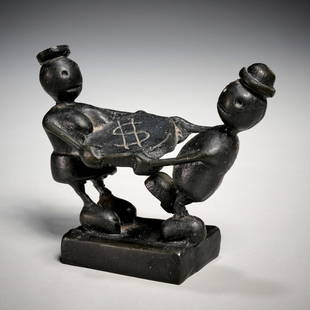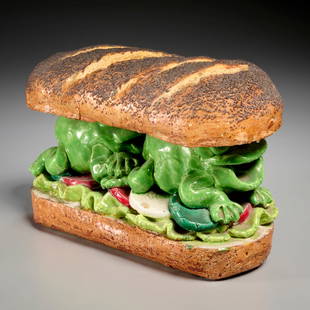
A MONUMENTAL HERACLES TERRACOTTA STATUE, GANDHARA
Similar Sale History
View More Items in Sculptures & CarvingsRelated Sculptures & Carvings
More Items in Sculptures & Carvings
View MoreRecommended Art
View More

















Item Details
Description
A MONUMENTAL HERACLES TERRACOTTA STATUE, GANDHARA, 4th - 5TH CENTURY
br>Terracotta, with recent wooden base, height 91 cm (without base)
Ancient region of Gandhara, Kushan period - 4th - 5th century
TL Test confirms the dating (see below)
This monumental, near life-size Kushan period Gandharan statue depicts Heracles seated in royal ease. The divine hero was at the time connected with Vajrapani and hence the first protector of Buddha. He shows an expressive, dominating face with bulging eyes, vividly curled hair and long beard. During the Kushan period, this type of bearded head was used for several male deities or heroes. such as Atlas or Dionysus and rarely, as in our example, for Heracles. Besides a loincloth Heracles is naked, as is the small female human figure next to him, who is holding a loincloth up to cover her lower body.
The kingdom of Gandhara lasted from 530 BC to 1021 AD, when its last king was murdered by his own troops. It stretched across parts of present-day Afghanistan and Pakistan. Gandhara is noted for its distinctive style in Buddhist art, which developed out of a merger of Greek, Syrian, Persian and Indian artistic influence. Gandharan style flourished and achieved its peak during the Kushan period, from the 1st to the 5th century. In the first century AD, Gandhara was the birthplace of some of the earliest Buddhist images.
The use of hard-fired ceramic instead of stone such as schist was popular during the later Gandharan period from the 4th to the 6th centuries C.E. Fired clay was expensive in the area, because the wood needed for the firing process was scarce. Therefore, such an expensive sculpture would have been a highly meritorious Buddhist offering. Only very few terracotta statues from this period and size have ever been recorded.
Shape: Figural shape
Dimensions: 91 x 88 x 25 cm (without the base)
Condition: Excellent, almost unique condition, fully consistent with the age of the sculpture, insignificant material loss to some exposed areas
Provenance: From the collection of Arthur Huc (1854-1932), France. The roots of this collection go back to Evariste Regis Huc (1813 - 1860), a French missionary and discoverer who became known for his travels through Mongolia, Tibet and China. Mr. Arthur Huc became the editor-in-chief of La Depêche in Toulouse in 1890 and was a popular political journalist and a reputed art critic until his death in 1932. In 1895 he married into the wealthy and noble Theron family from Marseille, which enabled him to expand the collection inherited from Evariste Huc. After his death, his collection was inherited by his wife, and, after her death, by their children. It was systematically inventoried and documented as complete collection in 1967 from which comes the hand-drawn sketch of this statue (see images online at www.zacke.at)
Scientific testing: A thermoluminescence test, conducted by Professor Dr. Ernst Pernicka at the REM laboratories of the Klaus Tschira Archaeometry Center at the University of Heidelberg, the corresponding written report #150344 dated January 12th, 2016, confirms an age of 2,000 years (with a tolerance of +/- 500 years) and states that “the age corresponds to the stylistic dating†of this statue.
Literature comparison: As Gandharan terracotta artworks are very rare and hardly ever appear on the market the examples given here show various examples from the Kushan period but not the same motif. See Christie's, Indian and Southeast Asian Art, 19 March 2013, NEW YORK, lot 212 (for a terracotta head of a bodhisattva) or Sotheby's, IMAGES OF ENLIGHTENMENT: DEVOTIONAL WORKS OF ART AND PAINTINGS, 17 SEPTEMBER 2014, NEW YORK, lot 410 (for a terracotta head of a Buddha)
Also see a Hadda region terracotta figure of a 'Thinking Bodhisattva'in the Dallas Museum of Art (accession no. 2010.17) and a terracotta Head of Dionysos, strongly resembling the Heracles present here, in the collection of the Metropolitan Museum of Art, New York (accession no. 1979.507.2)
四至五世紀健陀羅赫拉克勒斯陶像
紅陶,近代木底座,高 91 cm (不含底座)
健陀羅地區,貴霜帝國,四至五世紀
熱釋光測試證明
這個巨大的幾乎真人大小的貴霜時期健陀羅雕像刻畫了神聖英雄赫拉克勒斯坐像。當時赫拉克勒斯與執金剛神相關,因此也是佛陀的第一位保護者。他的臉部極其富有表現力,鋼勁有力的臉部曲綫,眼睛凸出,生動地捲曲的頭髮和長長的鬍鬚。在貴霜時期,這種鬍鬚頭被用於幾個男性神祗或英雄。如阿特拉斯或狄奧尼索斯,極少被使用于我們的赫拉克勒斯。除了纏腰布外,赫拉克勒斯赤身裸體的,旁邊還有一位身材矮小的女性人物,她正在拿著腰帶去遮住她的下半身。
健陀羅王國從公元前530年到公元1021年,當時的最後一個國王被自己的部隊殺害。健陀羅王國橫跨當今阿富汗和巴基斯坦的部分地區,以其獨特的佛教藝術風格而聞名,該藝術由希臘,敘利亞,波斯和印度的藝術影響力合併而成。從第一至第五世紀的貴霜時期,健陀羅風格盛行並達到鼎盛時期。在公元一世紀,健陀羅是一些最早的佛教圖像的誕生地。
在第四世紀到第六世紀後期,健陀羅使用硬質陶瓷代替石板(如片岩),在該地區燒製的粘土價格昂貴,因為燒製過程所需的木材稀缺。因此,這樣一個昂貴的雕塑將是一個非常有價值的佛教產品。從這個時期和規模來看,只有很少的兵馬俑雕像曾經被記錄下來。
人物形狀
尺寸: 91 x 88 x 25 cm (不含底座)
品相極好,幾乎獨一無二的保存狀況,完全符合雕塑的時代,一些暴露區域有微不足道的材料損失
來自法國亞瑟∙胡克 (1854-1932)收藏。這位藏家的收藏足跡可追溯到 他的祖先傳教士古伯察(法語名Evariste Regis Huc 1813 - 1860), 他在他的旅行中經過蒙古,西藏和中國。亞瑟∙胡克先生1890年曾是吐魯斯報社總編,直到1932年去世,他一直是一位很受歡迎政治記者與藝術評論家。1895年他聯姻馬賽貴族家庭特隆 Theron,使他能夠繼續擴大他從古伯察繼承而來的收藏。他去世後,他妻子接收收藏,在她之後,是他們的孩子們繼承。此收藏傳承有序,并在1967年進行了大規模的編錄工作,此像在那時候就已經有手繪素描 (見 www.zacke.at提供的在綫資料)
科學測驗:熱釋光測試由海德堡大學Klaus Tschira Archaeometry 中心REM laboratories 實驗室Ernst Pernicka 教授領導進行,檢測報告#150344,2016年1月12日,確認此像年齡為2,000年(誤差上下500年)並證實 “風格年代對應â€。
文獻參考:健陀羅陶像極其稀有,在市場上難得發現貴霜時期的類似作品,目前還沒有發現相同陶像。見佳士得《印第安與東南亞藝術》,2013年3月19日,紐約,212號拍品(一個菩薩頭像)或蘇富比《悟相:宗教藝術專拍》,2014年9月17日,紐約,410號拍品(一個菩薩頭部陶像)。
另見達拉斯美術館哈達地區“菩薩深思â€陶像 (no. 2010.17) 與戴欧尼修斯頭像,與紐約大都會藝術博物館中的赫拉克勒斯像極其相似 (no. 1979.507.2)
br>Terracotta, with recent wooden base, height 91 cm (without base)
Ancient region of Gandhara, Kushan period - 4th - 5th century
TL Test confirms the dating (see below)
This monumental, near life-size Kushan period Gandharan statue depicts Heracles seated in royal ease. The divine hero was at the time connected with Vajrapani and hence the first protector of Buddha. He shows an expressive, dominating face with bulging eyes, vividly curled hair and long beard. During the Kushan period, this type of bearded head was used for several male deities or heroes. such as Atlas or Dionysus and rarely, as in our example, for Heracles. Besides a loincloth Heracles is naked, as is the small female human figure next to him, who is holding a loincloth up to cover her lower body.
The kingdom of Gandhara lasted from 530 BC to 1021 AD, when its last king was murdered by his own troops. It stretched across parts of present-day Afghanistan and Pakistan. Gandhara is noted for its distinctive style in Buddhist art, which developed out of a merger of Greek, Syrian, Persian and Indian artistic influence. Gandharan style flourished and achieved its peak during the Kushan period, from the 1st to the 5th century. In the first century AD, Gandhara was the birthplace of some of the earliest Buddhist images.
The use of hard-fired ceramic instead of stone such as schist was popular during the later Gandharan period from the 4th to the 6th centuries C.E. Fired clay was expensive in the area, because the wood needed for the firing process was scarce. Therefore, such an expensive sculpture would have been a highly meritorious Buddhist offering. Only very few terracotta statues from this period and size have ever been recorded.
Shape: Figural shape
Dimensions: 91 x 88 x 25 cm (without the base)
Condition: Excellent, almost unique condition, fully consistent with the age of the sculpture, insignificant material loss to some exposed areas
Provenance: From the collection of Arthur Huc (1854-1932), France. The roots of this collection go back to Evariste Regis Huc (1813 - 1860), a French missionary and discoverer who became known for his travels through Mongolia, Tibet and China. Mr. Arthur Huc became the editor-in-chief of La Depêche in Toulouse in 1890 and was a popular political journalist and a reputed art critic until his death in 1932. In 1895 he married into the wealthy and noble Theron family from Marseille, which enabled him to expand the collection inherited from Evariste Huc. After his death, his collection was inherited by his wife, and, after her death, by their children. It was systematically inventoried and documented as complete collection in 1967 from which comes the hand-drawn sketch of this statue (see images online at www.zacke.at)
Scientific testing: A thermoluminescence test, conducted by Professor Dr. Ernst Pernicka at the REM laboratories of the Klaus Tschira Archaeometry Center at the University of Heidelberg, the corresponding written report #150344 dated January 12th, 2016, confirms an age of 2,000 years (with a tolerance of +/- 500 years) and states that “the age corresponds to the stylistic dating†of this statue.
Literature comparison: As Gandharan terracotta artworks are very rare and hardly ever appear on the market the examples given here show various examples from the Kushan period but not the same motif. See Christie's, Indian and Southeast Asian Art, 19 March 2013, NEW YORK, lot 212 (for a terracotta head of a bodhisattva) or Sotheby's, IMAGES OF ENLIGHTENMENT: DEVOTIONAL WORKS OF ART AND PAINTINGS, 17 SEPTEMBER 2014, NEW YORK, lot 410 (for a terracotta head of a Buddha)
Also see a Hadda region terracotta figure of a 'Thinking Bodhisattva'in the Dallas Museum of Art (accession no. 2010.17) and a terracotta Head of Dionysos, strongly resembling the Heracles present here, in the collection of the Metropolitan Museum of Art, New York (accession no. 1979.507.2)
四至五世紀健陀羅赫拉克勒斯陶像
紅陶,近代木底座,高 91 cm (不含底座)
健陀羅地區,貴霜帝國,四至五世紀
熱釋光測試證明
這個巨大的幾乎真人大小的貴霜時期健陀羅雕像刻畫了神聖英雄赫拉克勒斯坐像。當時赫拉克勒斯與執金剛神相關,因此也是佛陀的第一位保護者。他的臉部極其富有表現力,鋼勁有力的臉部曲綫,眼睛凸出,生動地捲曲的頭髮和長長的鬍鬚。在貴霜時期,這種鬍鬚頭被用於幾個男性神祗或英雄。如阿特拉斯或狄奧尼索斯,極少被使用于我們的赫拉克勒斯。除了纏腰布外,赫拉克勒斯赤身裸體的,旁邊還有一位身材矮小的女性人物,她正在拿著腰帶去遮住她的下半身。
健陀羅王國從公元前530年到公元1021年,當時的最後一個國王被自己的部隊殺害。健陀羅王國橫跨當今阿富汗和巴基斯坦的部分地區,以其獨特的佛教藝術風格而聞名,該藝術由希臘,敘利亞,波斯和印度的藝術影響力合併而成。從第一至第五世紀的貴霜時期,健陀羅風格盛行並達到鼎盛時期。在公元一世紀,健陀羅是一些最早的佛教圖像的誕生地。
在第四世紀到第六世紀後期,健陀羅使用硬質陶瓷代替石板(如片岩),在該地區燒製的粘土價格昂貴,因為燒製過程所需的木材稀缺。因此,這樣一個昂貴的雕塑將是一個非常有價值的佛教產品。從這個時期和規模來看,只有很少的兵馬俑雕像曾經被記錄下來。
人物形狀
尺寸: 91 x 88 x 25 cm (不含底座)
品相極好,幾乎獨一無二的保存狀況,完全符合雕塑的時代,一些暴露區域有微不足道的材料損失
來自法國亞瑟∙胡克 (1854-1932)收藏。這位藏家的收藏足跡可追溯到 他的祖先傳教士古伯察(法語名Evariste Regis Huc 1813 - 1860), 他在他的旅行中經過蒙古,西藏和中國。亞瑟∙胡克先生1890年曾是吐魯斯報社總編,直到1932年去世,他一直是一位很受歡迎政治記者與藝術評論家。1895年他聯姻馬賽貴族家庭特隆 Theron,使他能夠繼續擴大他從古伯察繼承而來的收藏。他去世後,他妻子接收收藏,在她之後,是他們的孩子們繼承。此收藏傳承有序,并在1967年進行了大規模的編錄工作,此像在那時候就已經有手繪素描 (見 www.zacke.at提供的在綫資料)
科學測驗:熱釋光測試由海德堡大學Klaus Tschira Archaeometry 中心REM laboratories 實驗室Ernst Pernicka 教授領導進行,檢測報告#150344,2016年1月12日,確認此像年齡為2,000年(誤差上下500年)並證實 “風格年代對應â€。
文獻參考:健陀羅陶像極其稀有,在市場上難得發現貴霜時期的類似作品,目前還沒有發現相同陶像。見佳士得《印第安與東南亞藝術》,2013年3月19日,紐約,212號拍品(一個菩薩頭像)或蘇富比《悟相:宗教藝術專拍》,2014年9月17日,紐約,410號拍品(一個菩薩頭部陶像)。
另見達拉斯美術館哈達地區“菩薩深思â€陶像 (no. 2010.17) 與戴欧尼修斯頭像,與紐約大都會藝術博物館中的赫拉克勒斯像極其相似 (no. 1979.507.2)
Buyer's Premium
- 27%
A MONUMENTAL HERACLES TERRACOTTA STATUE, GANDHARA
Estimate €7,000 - €15,000
15 bidders are watching this item.
Shipping & Pickup Options
Item located in Vienna, atSee Policy for Shipping
Payment

TOP










































































